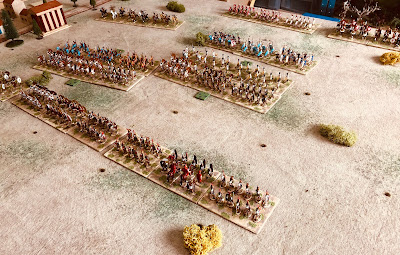The Battle of Aternum 213 BC is the second game in turn 3 of my solo ancients campaign. The setup for the game including: choice of terrain, order of battle, and deployment can be found on the previous post. As a quick reminder the battle is occurring in Southern Italy, and Carthage has the edge in terms of numbers of troops and with having Hannibal as the commander. These advantages are factored into the chance cards used by each army.
 |
| Deployed armies, Carthaginians on the left and Romans on the right. The buildings are considered impassible and light infantry can enter the woods (seen in the distance) on the other flank. |
Plans
The Roman commander's battle plan was quite simple and used the available terrain. Having the town and woods on either flank reduced the width of the battle line and would constrain any Carthaginian flanking moves with their cavalry. Roman light infantry were placed on either flank and would contest the woods to protect the flanks at best, or at worst frustrate any flanking efforts. In the centre the heavy infantry would try and engage as quickly as possible using their greater heavy infantry numbers to inflict as many losses as possible.
Carthage's plan was to hang on in the centre and take any limited flanking opportunities. Some light infantry were positioned in the centre to frustrate and delay the Roman centre. Hannibal was attached to a unit of heavy cavalry.
Game Report
 |
| Roman heavy infantry push forward as quickly as possible to engage the Carthage's heavy infantry. |
 |
| The fighting in the centre is a grind and with little threat from the flanks the Roman commander's plan seems to be working as they gain the advantage. |
 |
| With the loss of their heavy cavalry and commander the Carthaginian forces flee the field of battle. |
Summary
A Roman victory against the odds. The constrained flanks certainly did hamper the Carthaginian cavalry and they were not helped by a lack of rally cards in the earlier part of the game, those mercenaries can be unpredictable! Rome was aided by an initiative card on their first turn which caught Carthage's light infantry on the hop and they were quickly routed. Consistent combat dice rolls meant the pressure was maintained and they kept the initiative with Carthaginian attacks always seemingly in response to Romes attacks.
I was quite pleased to see a Roman victory from a campaign perspective. It now gives Rome a glimmer of hope as they try to build momentum and escape their dire campaign situation.
Possible Rule Changes
The rules which are heavily based on One-Hour Wargames rules, but adapted to use a D3 dice, have remained static for a good few games now. (There is a link to the rules at the top of the blog). I really do like the addition of chance cards to reflect the different army characteristics and force size.
However, one rule I want to mess around with is the commander rule. Currently, heavy units (infantry or cavalry) with an assigned commander can re-roll their combat dice if unhappy with the score. This rule does not feel like a decisive move made by a commander, so I plan to allow a commander to join a heavy unit at any point in the game and double the number of hits on the turn they join. They will only be allowed to do this once, and must remain with the unit from that point until the end of the game.




Nice action with large units. I see links to many of your D3 rules but not one for ancients. Am I overlooking that version?
ReplyDeleteWhoops! I forgot to add the page to the top. Thanks for mentioning.
DeleteWhat a turn up! But as you say I suppose cramping the flanks played to Rome's preferences. I think your commander rule change also makes sense as it was usually a desperation ploy.
ReplyDeleteIt was a pleasant surprise from a campaign view point for Rome to win. While there was not much terrain it was sufficient to hamper the Carthaginian flanking efforts. I will be giving the rule a try out next game.
DeleteGreat stuff, the campaign is looking less like a Carthaginian walkover now.
ReplyDeleteThanks. The campaign will definitely continue for a few more rounds.
DeleteAnother ripper Peter. Just like in history, you cannot right off those Romans; they have a knack of coming back, especially if they can use their greatest strength of the legions to full advantage while nullifying the strength of the opposition.
ReplyDeleteThe campaign is up for grabs again?
Regards, James
Hopefully the Roman resurgence will continue. The campaign is something I need to get back to soon.
Delete